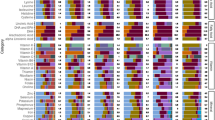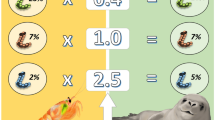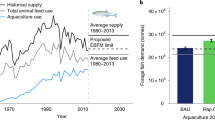Abstract
Long-chain omega-3 fatty acids—eicosapentaenoic and docosahexaenoic acids—are essential components of human diets and some aqua and animal feeds, but they are sourced from finite marine fisheries, and are in short supply and deficient in large parts of the world. We use quantitative systems analysis to model the current global eicosapentaenoic acid/docosahexaenoic acid cycle and identify options for increasing supply. Opportunities lie in increased by-product utilization and food waste prevention. However, economic, resource, cultural and technical challenges need to be overcome.
This is a preview of subscription content, access via your institution
Access options
Access Nature and 54 other Nature Portfolio journals
Get Nature+, our best-value online-access subscription
$29.99 / 30 days
cancel any time
Subscribe to this journal
Receive 12 digital issues and online access to articles
$119.00 per year
only $9.92 per issue
Buy this article
- Purchase on Springer Link
- Instant access to full article PDF
Prices may be subject to local taxes which are calculated during checkout


Similar content being viewed by others
Data availability
This work used data collected from a variety of sources—both proprietary and freely available. See the references in the Supplementary Information for data specification. All figures are based on this collected dataset, and geographically aggregated data (in more refined detail than the source data) will be made available on request from the corresponding author. Source data for Figs. 1 and 2 are provided with the paper.
References
Kris-Etherton, P. M., Grieger, J. A. & Etherton, T. D. Dietary reference intakes for DHA and EPA. Prostaglandins Leukot. Essent. Fatty Acids 81, 99–104 (2009).
Tocher, D. R. Omega-3 long-chain polyunsaturated fatty acids and aquaculture in perspective. Aquaculture 449, 94–107 (2015).
Stark, K. D., Van Elswyk, M. E., Higgins, M. R., Weatherford, C. A. & Salem, N. Global survey of the omega-3 fatty acids, docosahexaenoic acid and eicosapentaenoic acid in the blood stream of healthy adults. Prog. Lipid Res. 63, 132–152 (2016).
Worm, B. et al. Rebuilding global fisheries. Science 325, 578–585 (2009).
Tocher, D. R. Fatty acid requirements in ontogeny of marine and freshwater fish. Aquac. Res. 41, 717–732 (2010).
Sprague, M., Dick, J. R. & Tocher, D. R. Impact of sustainable feeds on omega-3 long-chain fatty acid levels in farmed Atlantic salmon, 2006–2015. Sci. Rep. 6, 21892 (2016).
The State of World Fisheries and Aquaculture (SOFIA) (FAO, 2016); http://www.fao.org/fishery/sofia/en
Rodrigues, B. L. et al. Fatty acid profiles of five farmed Brazilian freshwater fish species from different families. PLoS ONE 12, e0178898 (2017).
Tocher, D. R. Metabolism and functions of lipids and fatty acids in teleost fish. Rev. Fish. Sci. 11, 107–184 (2003).
Codabaccus, M. B., Ng, W. K., Nichols, P. D. & Carter, C. G. Restoration of EPA and DHA in rainbow trout (Oncorhynchus mykiss) using a finishing fish oil diet at two different water temperatures. Food Chem. 141, 236–244 (2013).
Hilborn, R. et al. When does fishing forage species affect their predators? Fish. Res. 191, 211–221 (2017).
Krill fishery report 2018 (CCAMLR, 2018); https://www.ccamlr.org/en/system/files/00%20KRI48%202018.pdf
Schram, L. B. et al. Food matrices affect the bioavailability of (n − 3) polyunsaturated fatty acids in a single meal study in humans. Food Res. Int. 40, 1062–1068 (2007).
Alder, J. & Pauly, D. On the Multiple Uses of Forage Fish: From Ecosystems to Markets (Fisheries Centre, Univ. British Columbia, 2006); https://open.library.ubc.ca/cIRcle/collections/facultyresearchandpublications/52383/items/1.0074759
EC Council. Regulation (EC) No 999/2001 of the European Parliament and of the Council of 22 May 2001 laying down rules for the prevention, control and eradication of certain transmissible spongiform encephalopathies. Off. J. EU 147, 1–40 (2001).
Wang, F., Zhang, J., Mu, W., Fu, Z. & Zhang, X. Consumers’ perception toward quality and safety of fishery products, Beijing, China. Food Control 20, 918–922 (2009).
Hamilton, H. A. & Peverill, M. S. & Müller, D. B. & Brattebø, H. Assessment of food waste prevention and recycling strategies using a multilayer systems approach. Environ. Sci. Technol. 49, 13937–13945 (2015).
Qi, B. X. et al. Production of very long chain polyunsaturated omega-3 and omega-6 fatty acids in plants. Nat. Biotechnol. 22, 739–745 (2004).
Spicer, A. & Molnar, A. Gene editing of microalgae: scientific progress and regulatory challenges in Europe. Biology (Basel) 7, E21 (2018).
Veloza, A. J., Chu, F. L. E. & Tang, K. W. Trophic modification of essential fatty acids by heterotrophic protists and its effects on the fatty acid composition of the copepod Acartia tonsa. Mar. Biol. 148, 779–788 (2006).
GLOBEFISH—Information and Analysis on World Fish Trade: Farmed Fish: a Major Provider or a Major Consumer of Omega-3 Oils? (FAO, 2017); http://www.fao.org/in-action/globefish/fishery-information/resource-detail/en/c/338773/
Gladyshev, M. I., Arts, M. T. & Sushchik, N. N. in Lipids in Aquatic Ecosystems (eds Kainz, M. J. et al.) 179–210 (Springer, 2009).
Stock, C. A., Dunne, J. P. & John, J. G. Global-scale carbon and energy flows through the marine planktonic food web: an analysis with a coupled physical–biological model. Prog. Oceanogr. 120, 1–28 (2014).
Strutton, P. G. & Chavez, F. P. Primary productivity in the equatorial Pacific during the 1997-1998 El Nino. J. Geophys. Res. 105, 260987–26101 (2000).
Acknowledgements
The authors thank E. O. Gracey (BioMar) and Y. Olsen (NTNU) for useful aquaculture insights and fruitful discussions. This research was supported by the research project MIRA (Microbially Produced Raw Materials for Aquafeed). MIRA is funded by the Research Council of Norway.
Author information
Authors and Affiliations
Contributions
H.A.H. and D.B.M. designed the study. H.A.H., R.N. and N.A.A. quantified the system and conducted the analysis. H.A.H. produced the figures. H.A.H., R.N., N.A.A. and D.B.M. contributed to data interpretation. H.A.H. wrote the paper. H.A.H., R.N., N.A.A. and D.B.M. contributed to editing the manuscript.
Corresponding author
Ethics declarations
Competing interests
The authors declare no competing interests.
Additional information
Publisher’s note Springer Nature remains neutral with regard to jurisdictional claims in published maps and institutional affiliations.
Supplementary information
Supplementary Information
Supplementary Fig. 1, methods, discussion and Tables 1–3.
Source data
Source Data Fig. 1
Numerical data used to generate Fig. 1.
Source Data Fig. 2
Numerical data used to generate figure 2, top (a) and bottom (b).
Rights and permissions
About this article
Cite this article
Hamilton, H.A., Newton, R., Auchterlonie, N.A. et al. Systems approach to quantify the global omega-3 fatty acid cycle. Nat Food 1, 59–62 (2020). https://doi.org/10.1038/s43016-019-0006-0
Received:
Accepted:
Published:
Issue Date:
DOI: https://doi.org/10.1038/s43016-019-0006-0
This article is cited by
-
Transcriptomics aids in uncovering the metabolic shifts and molecular machinery of Schizochytrium limacinum during biotransformation of hydrophobic substrates to docosahexaenoic acid
Microbial Cell Factories (2024)
-
Wild fish consumption can balance nutrient retention in farmed fish
Nature Food (2024)
-
Nutrient footprint versus EPA + DHA security in land-locked regions—more of local pond farmed, imported marine fish or fish oil capsules?
npj Science of Food (2023)
-
Microalgae and Thraustochytrids are Sustainable Sources of Vegan EPA and DHA with Commercial Feasibility
Indian Journal of Microbiology (2023)
-
Efficient co-production of EPA and DHA by Schizochytrium sp. via regulation of the polyketide synthase pathway
Communications Biology (2022)



